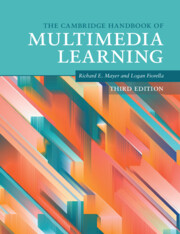Book contents
- The Cambridge Handbook of Multimedia Learning
- The Cambridge Handbook of Multimedia Learning
- Copyright page
- Contents
- Figures
- Tables
- Contributors
- Preface
- Acknowledgments
- Part I Background
- Part II Theoretical Foundations
- Part III Basic Principles of Multimedia Learning
- Part IV Principles for Reducing Extraneous Processing in Multimedia Learning
- Part V Principles for Managing Essential Processing in Multimedia Learning
- Part VI Principles Based on Social and Affective Features of Multimedia Learning
- Part VII Principles Based on Generative Activity in Multimedia Learning
- Part VIII Multimedia Learning with Media
- 37 Multimedia Learning with Cognitive Tutors
- 38 Multimedia Learning with Animated Pedagogical Agents
- 39 Multimedia Learning with Simulations
- 40 Multimedia Learning with Computer Games
- 41 Multimedia Learning with Instructional Video
- 42 Multimedia Learning in Virtual and Mixed Reality
- 43 Multimedia Learning with Visual Displays
- 44 Multimedia Learning from Multiple Documents
- 45 Multimedia Learning in e-Courses
- 46 Principles for Educational Assessment with Multimedia
- Author Index
- Subject Index
- References
39 - Multimedia Learning with Simulations
from Part VIII - Multimedia Learning with Media
Published online by Cambridge University Press: 19 November 2021
- The Cambridge Handbook of Multimedia Learning
- The Cambridge Handbook of Multimedia Learning
- Copyright page
- Contents
- Figures
- Tables
- Contributors
- Preface
- Acknowledgments
- Part I Background
- Part II Theoretical Foundations
- Part III Basic Principles of Multimedia Learning
- Part IV Principles for Reducing Extraneous Processing in Multimedia Learning
- Part V Principles for Managing Essential Processing in Multimedia Learning
- Part VI Principles Based on Social and Affective Features of Multimedia Learning
- Part VII Principles Based on Generative Activity in Multimedia Learning
- Part VIII Multimedia Learning with Media
- 37 Multimedia Learning with Cognitive Tutors
- 38 Multimedia Learning with Animated Pedagogical Agents
- 39 Multimedia Learning with Simulations
- 40 Multimedia Learning with Computer Games
- 41 Multimedia Learning with Instructional Video
- 42 Multimedia Learning in Virtual and Mixed Reality
- 43 Multimedia Learning with Visual Displays
- 44 Multimedia Learning from Multiple Documents
- 45 Multimedia Learning in e-Courses
- 46 Principles for Educational Assessment with Multimedia
- Author Index
- Subject Index
- References
Summary
There has been an explosion in the uses of multimedia and their various platforms. The proliferation of different types of technology inclusion in education has become even greater due to the increased need for remote platforms for education globally. My focus in this paper is on providing a definition of multimedia learning with simulations. There are many types of simulations and this chapter presents a framework for understanding this diversity. In particular, I discuss the multimedia principles that inform the design of simulations along with research evidence of how simulations support learning. Future directions for this research are discussed.
- Type
- Chapter
- Information
- The Cambridge Handbook of Multimedia Learning , pp. 461 - 471Publisher: Cambridge University PressPrint publication year: 2021
References
- 2
- Cited by

